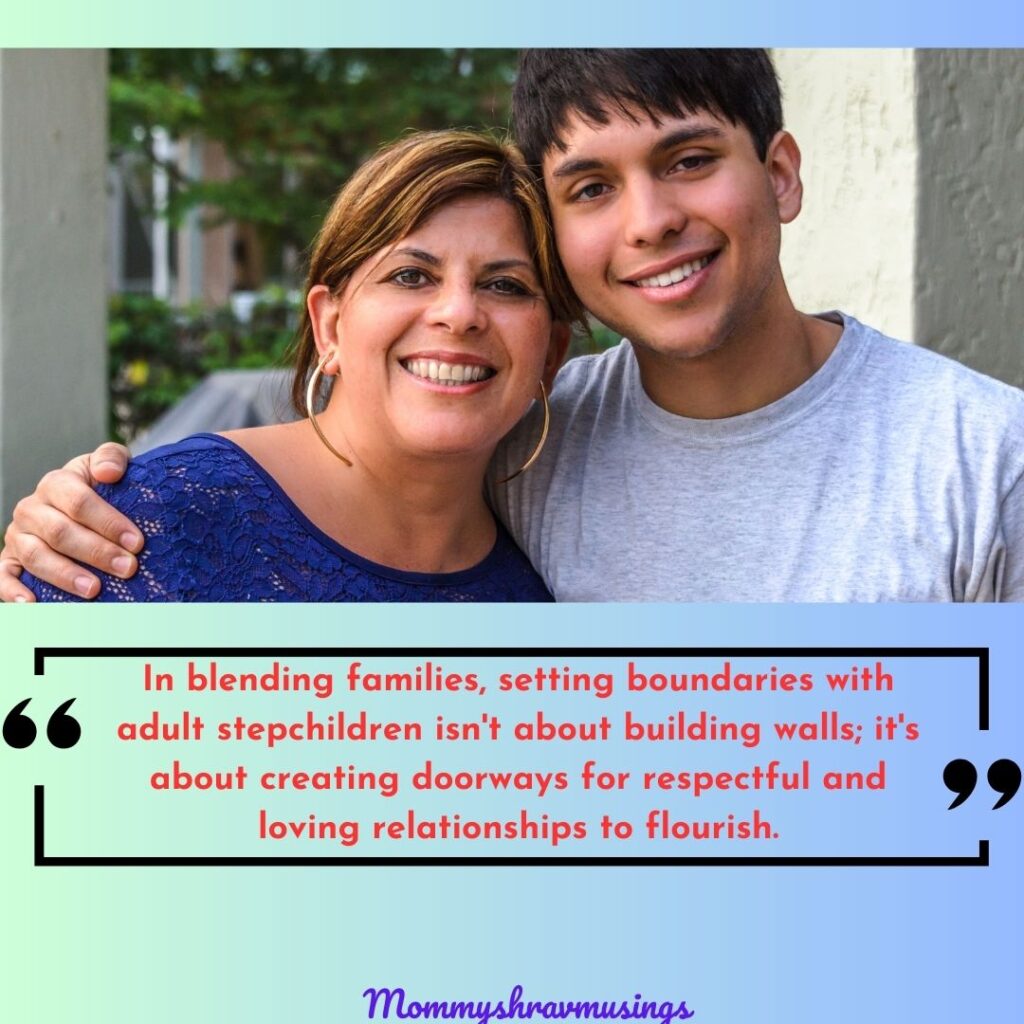Having adult stepchildren in your marriage can wreak havoc if not handled carefully. Your relationship with adult stepchildren will differ from that with your minor stepchildren. The journey of handling adult stepchildren will be more complex and intricate as it involves weaving together different backgrounds, experiences, and expectations. However, setting clear and respectful boundaries with them is the key to finding harmony. That’s why in this blog post, we deal with tips on how to set up boundaries with adult stepchildren.
Before we even go there to discuss how to set up boundaries with adult stepchildren, let’s first understand why those boundaries are needed in the first place.
Why do we need boundaries with Adult Stepchildren?
It’s always important to clearly define and establish your role with adult stepchildren. And these boundaries will help you determine your position with them. Here are some top reasons we must set boundaries with adult stepchildren.
1. Respect and Autonomy:
Adult stepchildren are autonomous individuals with their own lives, experiences, and responsibilities. Boundaries help ensure they are treated with respect and allowed to make their own decisions without undue interference.

2. Clarity and Expectations:
Setting boundaries clarifies what behaviors and interactions are acceptable within the family dynamic. This helps avoid misunderstandings, conflicts, and hurt feelings. This will help make everyone feel secure in the blended family system and comfortable with each other.
3. Managing Differences: Blending families can be challenging, especially when different family members have different backgrounds and values. Boundaries can help manage these differences and promote understanding and harmony. It will help us to define the roles and responsibilities clearly, to avoid potential conflicts in the future.
4. Emotional Well-being:
Boundaries protect the emotional well-being of all family members. They help prevent emotional over-involvement and maintain healthy emotional boundaries. This can avoid further hurt and conflicts among the family members.
5. Avoiding Parental Alienation: Setting boundaries can help prevent parental alienation, where one parent or stepparent attempts to turn the children against the other parent. Clear boundaries foster a healthy co-parenting environment. And in case of any conflicts, they can be resolved quickly.
We must never forget that building strong relationships and setting boundaries is an ongoing process. It requires continuous communication, mutual respect, and a commitment to understanding and supporting each other as a family.
Here are some tips for dealing with ungrateful stepchildren for you.
Types of boundaries to be established with adult stepchildren.
Now that we understand the importance of setting up boundaries with adult stepchildren, we need to establish these boundaries after a mutual discussion.
Emotional Boundaries:
Emotional boundaries involve respecting each other’s feelings and emotional well-being. It includes not taking responsibility for each other’s emotions and allowing each person to express themselves without judgment or criticism.
Do you think your stepchildren are manipulating you? Here are tips to find out how and handle your stepchildren.
Personal Space Boundaries:
Respect each other’s personal space and privacy needs. Discuss what level of privacy is expected, especially if living in the same household. Be considerate of each other’s time commitments and schedules.
Financial Boundaries:
Discuss and agree on financial matters, especially if shared expenses or financial support are involved. Set clear expectations regarding financial contributions and responsibilities.
Social Boundaries:
Respect each other’s social lives and commitments. Understand that adult children have their own friends and activities, and giving them space for their social interactions is essential.
Household Boundaries: If living together, establish rules for household chores, responsibilities, and expectations for maintaining a harmonious living environment. Also, discuss and agree upon the decision-making process in the family and who is responsible for what in the household.
Setting appropriate boundaries fosters a healthier and more respectful relationship with your adult children, promoting a positive and balanced family life. But we must remember that limits should be established through open communication and mutual understanding. So, we must be flexible and willing to adjust boundaries as the family dynamic evolves.
Tips on How to Set up Boundaries with Adult Stepchildren
1. Initiate a Conversation:
- Schedule a time to talk privately with your adult stepchildren. If required, you can also invite your spouse to this meeting.
- Let them know you want to discuss the family dynamics and establish healthy boundaries.
- Begin the conversation by expressing your positive intentions. Let them know that your goal is to create a harmonious and respectful family environment.
- Please share your thoughts, concerns, and expectations about the family, and invite them to share their thoughts.
- Present a unified front to avoid confusion and show that you both respect and support each other’s roles in the family.
2. Listen Actively:
- Encourage your stepchildren to share their thoughts and feelings about the family dynamic.
- Listen actively and empathetically without interrupting or becoming defensive.
- Focus on moving forward and creating a positive future together.
- Don’t talk about the past, and start building for a bright future together.

3. Respect Their Autonomy:
- Remember that they are adults with their own lives and decisions.
- Avoid being overly controlling or intrusive.
4. Set clear expectations and be Respectful:
- Define your boundaries clearly and explicitly. Discuss what behaviors are acceptable and unacceptable in your home or during interactions. Provide examples if necessary.
- Be consistent in upholding these boundaries.
- Demonstrate the boundaries you want to establish through your own actions and behavior.
- This will show that you are committed to the values you expect from everyone in the family.
5. Have an open mind:
- Be open to compromise and negotiation. Not all boundaries need to be set in stone.
- If your adult stepchildren have concerns or reservations about certain boundaries, discuss them openly and find ways to address them.
- Try to see things from your adult stepchildren’s perspective, as they might be having issues navigating through their own emotions and stress with the new family dynamic.
- Based on mutual agreement, be willing to adjust or modify them if necessary, which will help you build a positive and harmonious relationship.
6. Be Patient and Consistent
- Building trust and a healthy relationship with adult stepchildren takes time.
- Be patient with the process and avoid rushing things.
- Staying consistent is critical for establishing boundaries in any relationship. To enforce these boundaries in any event, even if you receive a pushback.
7. Avoid feeling guilty
- It is natural to feel guilty when setting boundaries with your own family members about whom you care about.
- However, it is important to remember that setting boundaries is essential to any relationship.
- So stop taking the blame on yourself and start feeling guilty when any conflict arises.
Here are a few tips for you to stop feeling guilty about being a bad mom.
8. Celebrate small wins:
- When you see positive changes and respectful behavior, acknowledge and appreciate it.
- Celebrate achievements in creating a healthier family dynamic.
9. Create New Traditions:
- Establishing new family traditions can help everyone feel included and foster a sense of belonging.
- These new traditions will provide opportunities to bond together as a family.
10. Seek professional help if needed:
- If you encounter persistent challenges in establishing boundaries or navigating relationships with adult stepchildren, consider seeking the support of a family therapist or counselor specializing in blended families.
Parting Thoughts:
By acknowledging the challenges that come with handling adult stepchildren and embracing the transformative power of boundaries, we can create a family environment where each member feels valued, respected, and supported. Clear emotional, communication, financial, and personal space boundaries provide the foundation for open and authentic interactions, enabling us to navigate the intricacies of blended family dynamics with grace and compassion.
Remember, establishing boundaries is an ongoing process that requires continuous communication, flexibility, and patience. As parents and stepparents, we have the unique opportunity to foster a nurturing atmosphere where our adult children can thrive, guided by the principles of mutual respect and genuine care.
QOTD: Ask your children – What boundaries mean to them and why we should have boundaries in our family.

Suhasini, IP, is the Author of the book “Practical Tips for Kids Mental Health.” As a certified kids and parents life coach, she helps/guides you toward a happy family life for your kids. She firmly believes that “Emotionally Happy Kids of today are the Mentally Strong and Happy Citizens of tomorrow.” Let’s make the world a happy and beautiful place for our kids to thrive.








[…] Here are some tips for communicating with your adult Step-Children. […]
[…] Here are some tips for talking effectively with your step-children. […]
[…] Here are some effective tips to set boundaries with your adult stepchildren. […]
[…] are some amazing tips for establishing boundaries with adult stepchildren without many power […]
[…] Santos points out that there is a absence of very clear boundaries amongst the three of you—which is specially fraught now that you all are residing in the exact […]
[…] start with, Santos details out that there is a absence of obvious boundaries in between the 3 of you—which is primarily fraught now that you all are residing in the similar […]
[…] Santos details out that there is a absence of distinct boundaries between the 3 of you—which is specially fraught now that you all are residing in the same house. […]